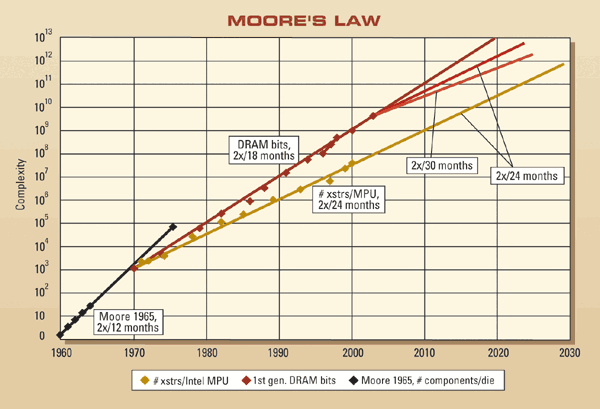CSC/ECE 506 Fall 2007/wiki1 1 ab
Moore's Law in the Future
In 1965, Gordon Moore famously observed a growth trend in microprocessor technology that has held true ever since. His prediction that microchip feature density would double every 18 months has proven largely correct despite the incredible changes the industry has seen since the 1960s. In some ways, the "law" predicted by Moore has been a self-fulfilling prophecy, pushing the industry to meet its Moore's Law "quota" and drive feature sizes down and clock rates up.
It is predicted that the Moore's Law trend will continue for some time. Chip manufacturers continue to make design improvements that perpetuate the continual increase in chip complexity.[1] While increasing the number of transistors on a chip seems to directly impact the single-processor area of computing, it also has numerous implications in the multiprocessor regime. Of course, increased density yields increased performance in all types of computers, but it also allows for new types of parallel processors such as the now-common single-ship multi-core CPU. Incorporating parallel computing principles onto a single chip has made the benefits of parallelism more affordable even for everyday consumers, and this trend can be expected to continue.
From http://www.semiconductor.net/article/CA405656.html
Price vs. Performance
Affordability is always the bottom line in technology development; better performance is nearly always physically possible, but is limited by economic practicality. As multiprocessor architecture improves, however, ideas which were once unfeasible become more and more realistic. Large computing clusters made up of arrays of several average-to-high performance machines have led the affordability trends for some time.[2] This is largely due to the fact that such clusters are comprised of readily-available computer systems in large quantities and can be assembled easily, without much architecture expertise.
As previously mentioned, single=chip parallel processors are also becoming the norm in the consumer PC market. As it becomes more and more difficult to increase clock rates past their current levels, architects are making up the difference by simply adding more processor cores to their chips. Quad-core CPUs are already available, but even larger numbers will be available in the near future.[3]
Conclusion
Ultimately, the same trends which have emerged since the development of the microprocessor show signs of continuing into the foreseeable future. Trends which have long applied to single-processor applications appear to scale proportionally when more processors are added to the implementation in a parallel fashion. However, there is a limit to how densely transistors can be produced on a chip, so Moore's Law will not hold indefinitely. Instead, multiprocessing will take over the majority of the performance gains. This will allow the end-user performance benefits of Moore's predictions to continue even when the root cause of the benefits has changed.
